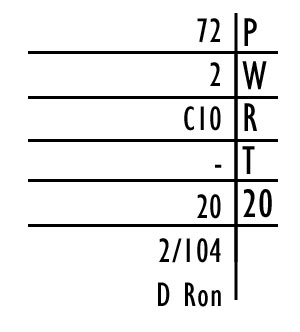Scoring a hand quickly and correctly requires you to count each type of fu, the applicable yaku and han thereof, and then converting the han and fu into the actual score. This guide is not necessarily the best method to score hands in person – it does things out of the normal order to cut down on time so you can get an answer as soon as possible, and catch extremely rare situations that are specifically stress-tested on the exam. Many times, the questions you are given on the exam for scoring are one-in-a-hundred / one-in-a-thousand hands, that specifically require exact knowledge and arithmetic to score properly.
Counting Han
Make a point to check for specific Yaku that are easily overlooked when being rushed:
- San Ankou
- San Kantsu
- Sanshoku Dokou
- Menzen Tsumo
- any other Yaku you miss in practice tests (some people overlook Tanyao. I overlook Junchan. Keep track of your mistakes)
In addition, when there is overlapping mentsu (45556, 3344556), look for alternate ways to make the mentsu. Generally, this means either picking a different pair for the finished hand, or taking adjancent tiles as either ankou or sequence – to see if there are other possible yaku considerations.
For example: 45556 AAA BBB CC win on 5 can be:
– san ankou inner wait (4_6 555 AAA BBB CC), or
– just a double pair wait (456 55 AAA BBB CC)
Another example: 234m 234p 2233445s win on 5 can be:
– tanyao iipeikou pinfu (234m 234p 22 345 34s), or
– tanyao sanshoku iipeikou(234m 234p 234 234 5s)
Another example: 1177778888999 win on 9 can be:
– san ankou (11 777 888 999 78), or
– ryanpeikou junchan pinfu (11 789 789 789 78)
Lastly, if the Han count is high enough, skip counting fu.
Counting Fu
655 nnn[-p0000000000000000 0000000000000000000000000000000000 000000000000000000000000000000000000 00000000000000000000000000087x
– this was typed by my cat while i worked on this and i’m keeping it in here
– Mentsu
32: closed kan of outside tile (outside = 1,9,dragon,wind)
16: open kan of outside tile / closed kan of inside tile (inside = 2 through 8)
8: open kan of inside tile / closed triplet of outside tile
4: open triplet of outside tile / closed triplet of inside tile
2: open triplet of inside tile
0: sequence
An alternative memorization is : all triples are 2. x2 if outside, x2 if fully hidden, x4 if a kan.
Practice adding mixtures of these numbers, high to low.
– Pair
2: if having 3 of your pair tile would be a yaku (dragon, table wind, seat wind). Note in many pro rulesets, it still worth 2 regardless of how many different yaku it is. (For example, East pair for a dealer on East round)
– Wait
2: if you do not have pinfu and can create a hand makeup that only accepts 1 tile.
Look for tricky ones, such as a  win on
win on 


 : this can be 2 fu for having taking it as a pair wait on the
: this can be 2 fu for having taking it as a pair wait on the  (
(


 ) instead of a
) instead of a 
 wait. Another common example is
wait. Another common example is 




 , the 2p can be taken as
, the 2p can be taken as 
 .
.
A general way to get the 2fu for the wait correctly is that, if there is no pinfu or ankou count consideration, if the tile is in the center of a mentsu, or the 3 or 7 in a penchan (123 / 789), it is worth 2. for example, with 12334, a 5 is worth 0 fu (123 345 is the final resule), but a 2 can be worth 2 fu (123 234 is the final result, and a 2 is in there.
– Win Bonus
10: closed Ron
2: Tsumo without pinfu
– Base
20: all hands
(total is 25 if hand is 7 pairs)
– Round
if not on a 10, round up to next 10 (7 pairs is still 25)
Raw Score from Han+Fu
This is where you memorize the scoring chart, up through 110 fu. There are very little shortcuts here – the raw formula is not as fast as simply knowing all the scores in advance.
If you are looking for some slight help:
- Tsumo is a sliding scale: for example, 40 fu tsumo is 400-700-1300-2600. 1&40 is 400/700, 2&40 is 700/1300, etc.
- Lose 1 han, double the fu: 3&25 = 2&50 = 1&100. 4&20 = 3&40 = 2&80.
- 50 fu is computer numbers: 4/8/16/32/64. On the dealer side it is the numbers between those: 6/12/24/48.
- 70 fu counts up after the first number: 12,23,45. 600/1200/2300/4500. Memorize “1223456”, move the 6 to the front, and you have 6/12/23/45. For dealer, memorize “3468”: 34/68. Both are “counting but bad at it”.
- 90 fu is the score for 40fu + the score for 50fu. 110 fu is 60+50. This actually works for all scores above 50 fu (50fu + the difference) because 50fu scores have no rounding, but using it for 70 fu is difficult because 1&70 is 1&50+1&20, and you don’t learn 1&20 because it isn’t possible in modern riichi.
- grinding games will get you well acquainted with 30/40/50 fu. 60/80/100 are just those minus 1 han. 70/90/110 you should specifically memorize.
Preferred: Piece-by-Piece Method
If you are having an issue with still forgetting tusmo and ron bonuses, or forgetting a triplet, try writing left-to-right, one piece at a time.
- Han list
- Dealer / Non-Dealer (or Wind)
- Open / Closed hand
- Ron / Tsumo
- A space for final calculations
- Then, the 7 numbers that make up the Fu:
- Each of the 5 hand pieces, left to right, whether set pair or sequence
- The wait
- The base including win bonus (20/22/25/30)
- The total
Here are a couple of examples, working the answer in from each side. While it requires more small-number math, it keeps the important parts near the score, and lets you see early if you can skip the fu.
Player East, Table East













 Ron on
Ron on 
Yakulist (San Ankou), East, Closed, Ron, on one side, and then
8 for the triplet of 1m, 0 for the sequence, 0 for the pair, 32 for the closed kan, 32 for the next one, Wait 2, Base 30, which adds to 104.
SAK:2, E, C,R : 8,0,0,32,32,2,30:104
2 from one side, 110 from the other, 2 / 110 Dealer Ron.

Player West, Table East












 Tsumo on
Tsumo on 
Yakulist (E, R, Chanta), West, Open, Tsumo, on one side, and then
Base 22, Wait 2, 0 for the pair, 0 for the sequence, 8 for the Red, 16 for the E, nothing for the sequence, which adds to 48. 3/50 Non Dealer Tsumo.

This is the method I prefer both to use and to teach. However, alternate methods are below.
Alternate Method: Step-by-step
- Han
- Sets
- Pair
- Wait
- Win Bonus
- Base
- Round
You can go through this by a left-to-right, right-to-left pass, making notes on each part.
Example 1
Player East, Table East














 Ron on
Ron on 
Left to right: “Dealer. Yaku are.. San Ankou, the end. 2 han. Hand is closed. Ron.” then, looking at sets right to left, “32 (for 9s closed kan)..64 (for 1p closed kan).. still 64 (234 is no points).. 72 (closed set 1m). no yaku pair. single tile wait, 74. closed Ron, 84. plus Base, 104. Round, 110. 2 & 110 Dealer Ron, 10600.” Approximate time, 20 seconds.
Example notetaking method: Parts, Wait, Ron, Tsumo, Base. Note that Ron/Tsumo starts with O if the hand is open, C if the hand is closed, TP if the hand is Tsumo Pinfu, so you don’t +10 an open Ron. miss a +10 on a closed one, or mess up a +2 that you should or shouldn’t have. Depending on your preference, you can split out pair from the parts, open and closed parts, etc. Also, you can write the yaku/han beneath the score, whatever you need to keep the correct information in mind.

Example 2
Player East, Table East














 Tsumo on
Tsumo on 
Left to right: “Dealer. Yaku are.. Toi toi, the end. 2 han. Hand is open. Tsumo.” then, looking at sets right to left, “32 (for S closed kan)..48 (for 1m open kan)..50 (for open set of 4s).. 58 (closed set 9m due to tsumo). Yaku pair, 60. Tsumo, 62. Base, 82. Rounding, 90. 2&90, Dealer Tsumo, 2900 all.” In the notes, it is written next to the last answer (left or right, your preference), as notetaking is set up so you can do a long line of these one after another.

More Complex Notetaking Method
If you are finding that you are still dropping things (such as missing Menzen Tsumo, or miscounting wait and pair fu, etc), here is a longer breakdown that catches most things.
- Numerical: Base, Parts (outside), Parts (inside), Pair, Wait, Win Bonus
- Non-numerical: Open/Closed Ron/Tsumo, Wind
- List Yaku
Table East, Player East













 Ron on
Ron on 

This allows you to get all the pertinent information together into one area, so you aren’t looking all around, and you can double-check “okay, this is Closed Ron, so win is 10. I’m dealer, so score it like that”. Figure out what works best for you!
